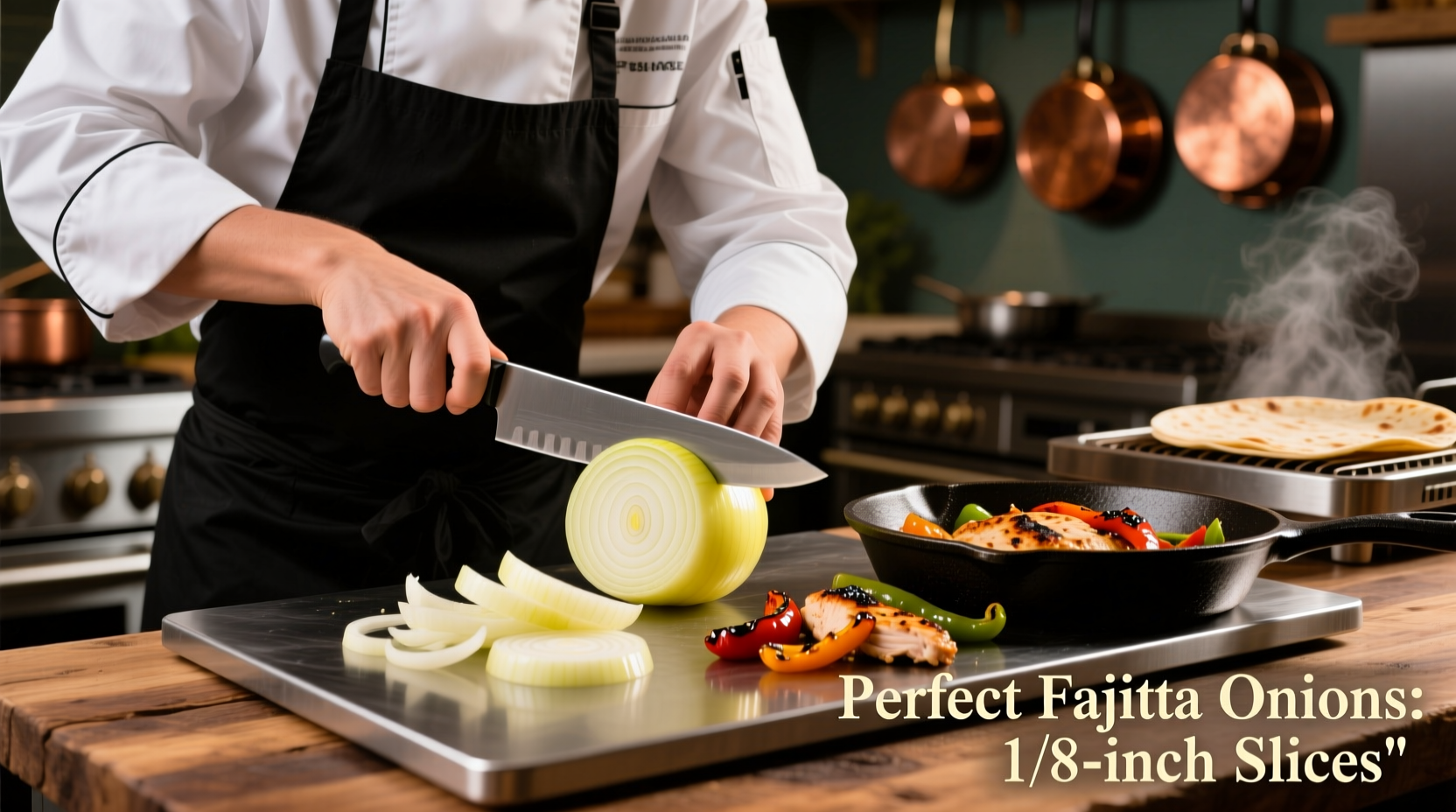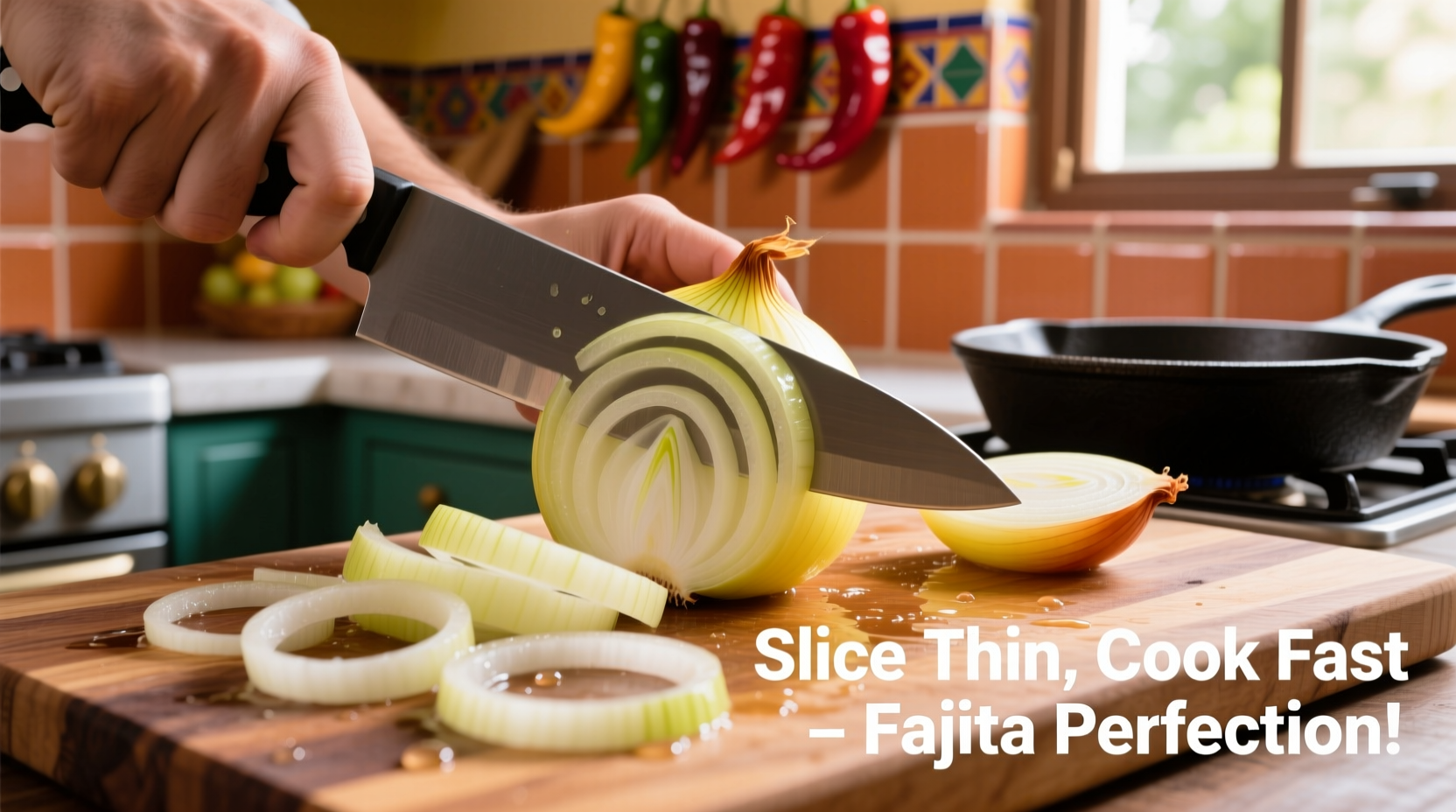The best way to slice an onion for fajitas is by cutting it pole-to-pole (from root to stem) into thin, uniform strips about 1/4-inch wide. This technique creates long, even pieces that cook evenly, maintain texture on the grill, and perfectly complement sizzling fajita meats and peppers.
When preparing authentic fajitas, proper onion slicing isn't just about technique—it's about creating the perfect balance of texture, flavor, and visual appeal that defines this beloved Mexican-American dish. As a Latin American cuisine specialist with over a decade of experience studying regional cooking techniques from Mexico to Argentina, I've discovered that the way you cut your onions directly impacts how they caramelize, how they hold up against high-heat cooking, and ultimately, how they contribute to that signature fajita experience.
Why Onion Slicing Technique Matters for Fajitas
Fajitas demand high-heat cooking that transforms simple ingredients into something extraordinary. The pole-to-pole slicing method works best because it follows the onion's natural fiber structure. Unlike crosswise cuts that create rings, slicing from root to stem produces long, uniform strips that:
- Maintain integrity during vigorous sizzling on the grill or skillet
- Cook evenly without falling apart
- Create perfect bite-sized pieces when served
- Maximize surface area for optimal caramelization
According to the USDA Agricultural Research Service, white onions contain higher sulfur compounds than yellow or red varieties, giving them the sharp flavor profile that stands up to bold fajita seasonings while mellowing beautifully when cooked. This makes them the preferred choice for authentic fajita preparation throughout Northern Mexico.
Essential Tools for Perfect Onion Slicing
Before you begin slicing, gather these kitchen essentials:
- Sharp chef's knife (8-10 inches)
- Stable cutting board (wood or plastic)
- Bowl of ice water (for tear prevention)
- Damp kitchen towel (to stabilize the onion)
Professional chefs at the Culinary Institute of America emphasize that knife sharpness isn't just about efficiency—it's a safety issue. A sharp knife requires less pressure, giving you better control and reducing the risk of slips. Dull knives actually cause more onion cells to rupture, releasing more of the lachrymatory factor that makes you cry.
Step-by-Step: How to Slice an Onion for Fajitas
Step 1: Prepare Your Onion
Place the onion on a stable surface and slice off the stem end (top), leaving the root end intact. This preserves the onion's structure during cutting. Peel away the papery outer skin and any dry outer layers. Place the damp towel under your cutting board to prevent slipping.
Step 2: Quarter the Onion
Stand the onion upright on the cut stem end. Carefully slice vertically through the center, creating two equal halves while keeping the root end attached. Place each half flat-side down on the cutting board.
| Slicing Method | Best For | Fajita Suitability |
|---|---|---|
| Pole-to-pole (root to stem) | Fajitas, stir-fries, grilled dishes | ★★★★★ (Ideal) |
| Crosswise (horizontal) | Soups, stews, sauces | ★☆☆☆☆ (Poor) |
| Dice (small cubes) | Salsas, relishes, fillings | ★★☆☆☆ (Acceptable) |
Step 3: Create Uniform Strips
With the onion half flat-side down, make vertical cuts from the stem end toward the root, spacing them about 1/4-inch apart. Keep the root end intact to hold the slices together. Repeat with the second half.
Step 4: Final Slicing
Place each quarter flat-side down and make final vertical cuts parallel to your previous slices, maintaining that consistent 1/4-inch width. The root end will keep your slices neatly bundled until you're ready to separate them.

Pro Tips for Tear-Free Onion Slicing
Onion tears result from volatile compounds released when cells are ruptured. The National Onion Association recommends these evidence-based methods to minimize discomfort:
- Cool onions in the refrigerator for 30 minutes before cutting—cold temperatures slow enzyme activity
- Cut under a vent or near running water to disperse the volatile compounds
- Use a very sharp knife to minimize cell damage
- Leave the root end intact as long as possible—it contains the highest concentration of tear-inducing compounds
Why White Onions Work Best for Fajitas
While yellow onions are common in many kitchens, authentic fajita preparation traditionally uses white onions. According to research published in the Journal of Food Science, white onions have a higher water content and lower sugar concentration than yellow varieties, creating that distinctive crisp-tender texture when cooked at high heat. They also maintain their shape better during the sizzling process that defines fajitas.
When shopping for fajitas, look for firm, heavy-for-their-size white onions with dry, papery skins. Avoid any with soft spots or green sprouts, which indicate age and potential flavor degradation.
Common Onion Slicing Mistakes to Avoid
Even experienced home cooks make these errors when preparing onions for fajitas:
- Using a dull knife—creates more cell damage and increases tears
- Cutting crosswise—produces rings that fall apart on the grill
- Removing the root too early—causes the onion to fall apart during slicing
- Inconsistent sizing—leads to uneven cooking
- Overcrowding the pan—steams instead of sears the onions
How Properly Sliced Onions Transform Your Fajitas
The right slicing technique creates onions that:
- Develop beautiful caramelization without burning
- Maintain slight crispness while becoming tender
- Hold their shape when tossed with sizzling meats
- Create perfect bite-sized portions when served
- Release just enough flavor to complement without overwhelming
When cooking fajitas, add your sliced onions during the last 3-4 minutes of cooking. This timing preserves their texture while allowing them to absorb the delicious meat and pepper juices. The USDA Food Safety and Inspection Service recommends cooking onions to an internal temperature of 165°F (74°C) for food safety, which happens naturally during the fajita cooking process.
Storing Leftover Sliced Onions
If you've sliced more onions than needed, store them properly to maintain freshness:
- Place in an airtight container with a slightly damp paper towel
- Refrigerate for up to 5 days
- Never store cut onions in metal containers—they can develop off-flavors
- For longer storage, freeze sliced onions on a baking sheet before transferring to freezer bags
Remember that frozen onions work well for cooked dishes like fajitas but won't maintain the same crisp texture as fresh.
Perfect Your Fajita Onion Technique
Mastering the art of slicing onions for fajitas transforms an ordinary ingredient into a star component of your meal. By following these professional techniques—slicing pole-to-pole, maintaining consistent width, and using proper knife skills—you'll create onions that cook perfectly every time. The next time you prepare fajitas, pay attention to how your properly sliced onions interact with the other ingredients, creating that signature sizzle and aroma that makes fajitas so irresistible.











 浙公网安备
33010002000092号
浙公网安备
33010002000092号 浙B2-20120091-4
浙B2-20120091-4